OnePlus 8T review: More power, more features
It's like a smaller OnePlus 8 Pro.
OnePlus phones have rarely disappointed us over the past seven years. I was very impressed by the flagship OnePlus 8 Pro when it launched back in April, and it even became my main phone for a while. But for most OnePlus fans, the 8 Pro had a glaring problem: it was an unusually expensive device for the company, on par with Samsung’s Galaxy S20. It was a bold move, but maybe a necessary one to cover OnePlus’ increasingly costly production and marketing.
Still, the company eventually returned to its budget roots with the mid-range Nord three months later. While it offered a similarly slick overall experience, OnePlus cut corners in terms of performance and body materials. That’s not to say the Nord was a bad phone; it was great for its price, but some of us always yearn for a more powerful smartphone at a more affordable cost -- like the original $300 OnePlus One of yore.
This is where OnePlus’ 8T comes in. It’s essentially the OnePlus 8 with extras -- some of which match or even outdo what the 8 Pro offered, in fact. In the US, you'll get the device with 12GB RAM and 256GB of the newer UFS 3.1 storage for $750. That puts it right between the OnePlus 8 (from $699) and the 8 Pro (from $899) with the same config. In other words, for an extra $50, you’re getting a device that’s more like a flagship phone, yet still noticeably cheaper than the competition.
That being said, it’s not the most powerful phone out there. The 8T still uses the Qualcomm’s Snapdragon 865 processor and LPDDR4x RAM seen in the OnePlus 8. Don’t worry: this is perfectly fine for most people. You’d only need the 865 Plus if you want that extra oomph for more intense gaming, and OnePlus’ RAM Boost seems to ensure fast loading time for frequently-used apps, even if it’s not using the newer, faster LPDDR5 RAM. Personally, my bigger concern was that my OnePlus 8T couldn’t connect to Hong Kong’s 5G networks here, due to some missing bands on the US model.
Design
As for colors, there are only two options: “aquamarine green” and “lunar silver.” OnePlus sent me the former, and while I tend to prefer frosted glass bodies like on the OnePlus 8 Pro and the LG Wing, the 8T’s ceramic glaze-like glossy finish grew on me.
OnePlus also claims that its new coating method renders fingerprints less visible through some optical trickery. In real life, it worked a bit, but usually only when I looked straight on. Not that it mattered too much to me, as I like to keep my phones in their cases. With my review sample, OnePlus provided a “cyborg cyan” case and a cyan sandstone case, and I picked the former for its dorky translucent circuitry look.
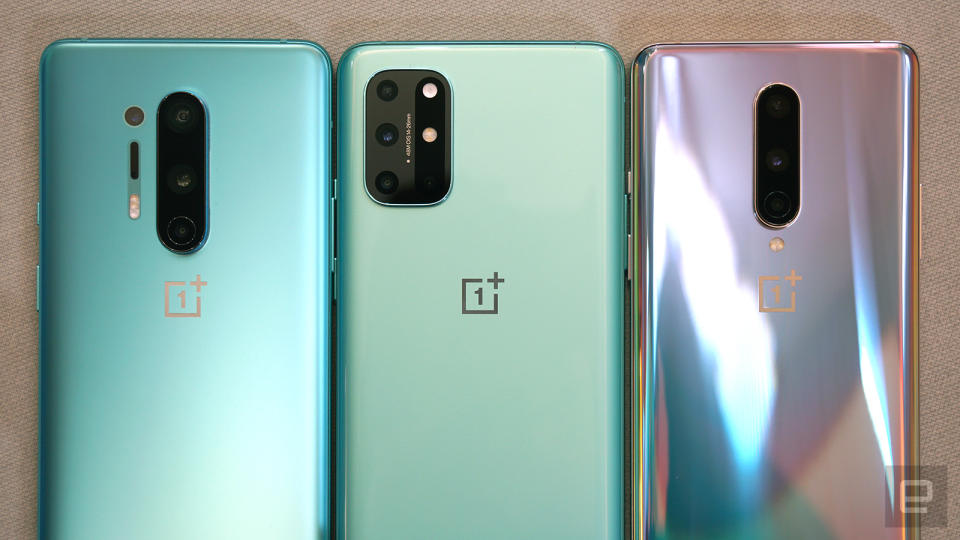
To my surprise, the OnePlus 8T received a major redesign on the back, and I have mixed feelings about it. Ever since the OnePlus 6 up to the OnePlus 8 series, I like how the phones have kept the rear cameras vertically aligned along the center. This required more engineering work, but I think it gave OnePlus phones a unique design identity at a time when most smartphones have never been more samey.
With the 8T, OnePlus stuffed everything into an increasingly common rectangular island at the top left corner, in order to make more space for other parts. I wouldn’t go as far as calling it ugly, but when placed next to other OnePlus 8 phones, the 8T just doesn’t look as good. The camera island bears a strong resemblance to the modules on Samsung’s Galaxy S20+ and its cheaper cousins.

Display
Another major change on the 8T is the display. It’s still a 6.55-inch 2,400 x 1,080 Fluid AMOLED panel, but now with a smoother 120Hz refresh rate -- matching that of the 8 Pro’s larger, sharper screen. This makes the 8T one of the most affordable flagships with such a fast display, alongside the Galaxy S20 FE. As a bonus, the OnePlus 8T has 8,192 levels of brightness (doubling what the 8 offered), with a peak brightness of 1,100 nits which made it a bit easier for me to read outdoors -- more so than my other phones. There are also ambient sensors on both sides of the phone to help maintain a more accurate auto-brightness.
OnePlus also took a page out of Samsung’s book and switched back to a flat screen, after several devices with sloping edges. It may look less elegant, but it is more practical. For one, you’ll no longer suffer from glare reflected by the curves while watching videos or playing games, and curved edges often increase the chances of accidental taps and, worse, drop damage. Reverting to a flat screen also meant increasing interior space, which allowed OnePlus to boost the battery size to 4,500mAh -- basically matching that of the 8 Pro. I certainly won’t miss the curved screen for all these reasons.
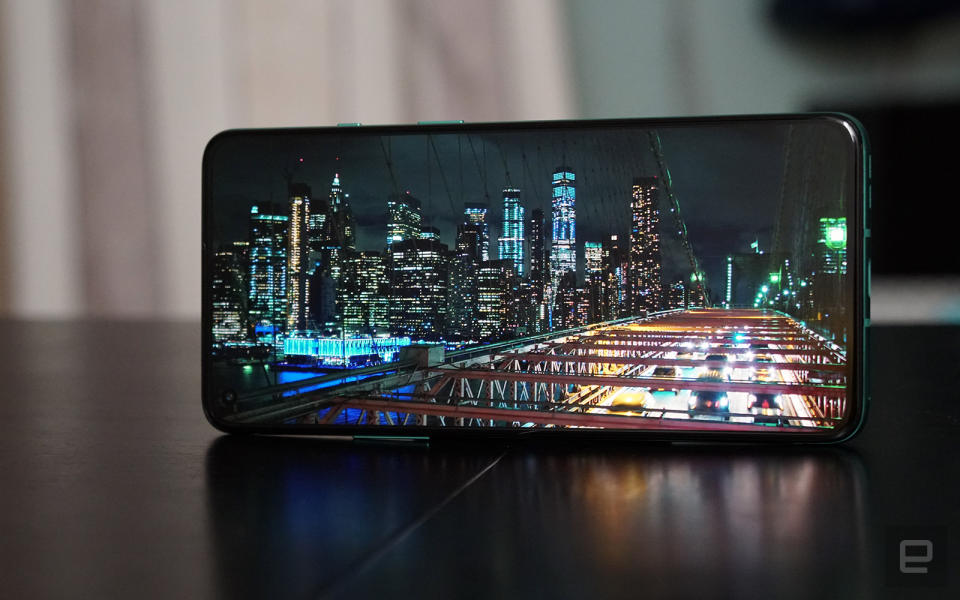
I struggled to find faults on the 8T’s carefully calibrated screen. HDR videos on both Netflix and YouTube looked stunning (with the bonus of particularly loud Dolby Atmos stereo speakers), and I felt that the 120Hz refresh rate made apps and OxygenOS run a tad smoother than they already did on the 8’s 90Hz panel, though not everyone may notice this difference. Just out of curiosity, I fired up PUBG Mobile with HDR graphics plus “extreme” frame rate enabled. I felt like this boosted my response time and made spotting enemies easier in some instances, and it certainly made the game more enjoyable.
Warp Charge 65
When it comes to charging, OnePlus jumped from 30W all the way to 65W for its latest Warp Charge adapter that comes with the OnePlus 8T. This takes the battery from zero to 42 percent in just 10 minutes, or to a full charge in a mere 39 minutes. Yes, this charging tech is the same as Oppo’s 65W SuperVOOC 2.0 and Realme’s 65W SuperDart -- both chargers were identified as “Warp Charge 65” on my 8T when plugged in, so long as certified VOOC-type cables were part of the combination. It’s fast and incredibly convenient.
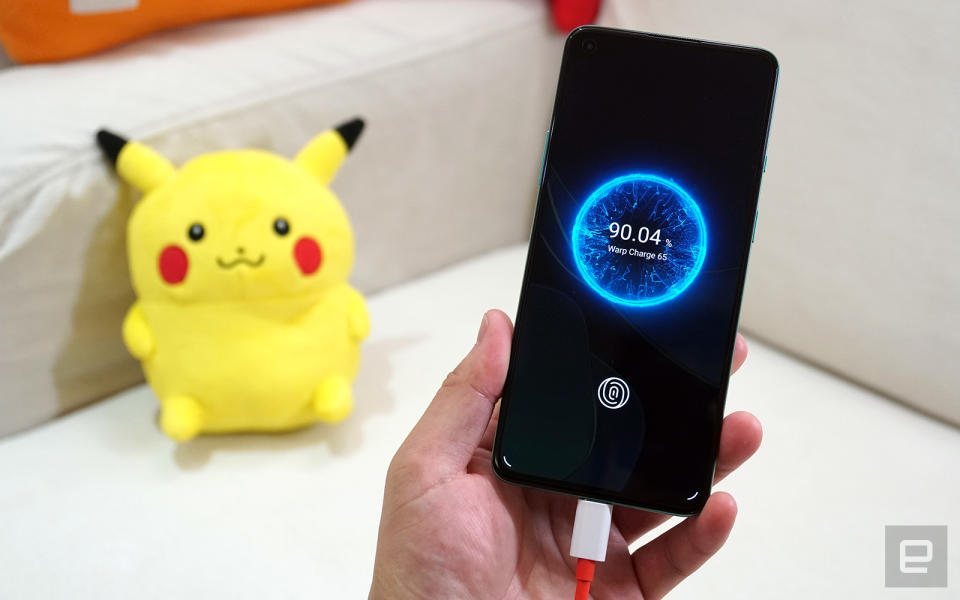
I must admit, I did miss this impressive charging speed after migrating from the Find X2 Pro to other smartphones, so it was nice to come back to this Oppo tech by way of OnePlus. But that’s not all. The Warp Charge 65 adapter doubles as a 45W USB-PD charger, so it can power a wider variety of gadgets -- namely a Nintendo Switch or even a laptop -- using any USB-C to USB-C cable. As for the OnePlus 8T itself, it can also work off any USB-PD charger at up to 27W, but it’ll obviously charge at a much slower rate.
Much like the OnePlus 8, the 8T also lacks wireless charging. Personally, I’m fine with that because sometimes I want to be able to hold my phone while charging, not to mention that wired charging still tends to be much faster. That said, I can see how some folks might not like this decision. If you have invested heavily in the wireless charging ecosystem and want the OnePlus experience, then you may have to consider the slightly heavier (and slightly more expensive) 8 Pro instead.
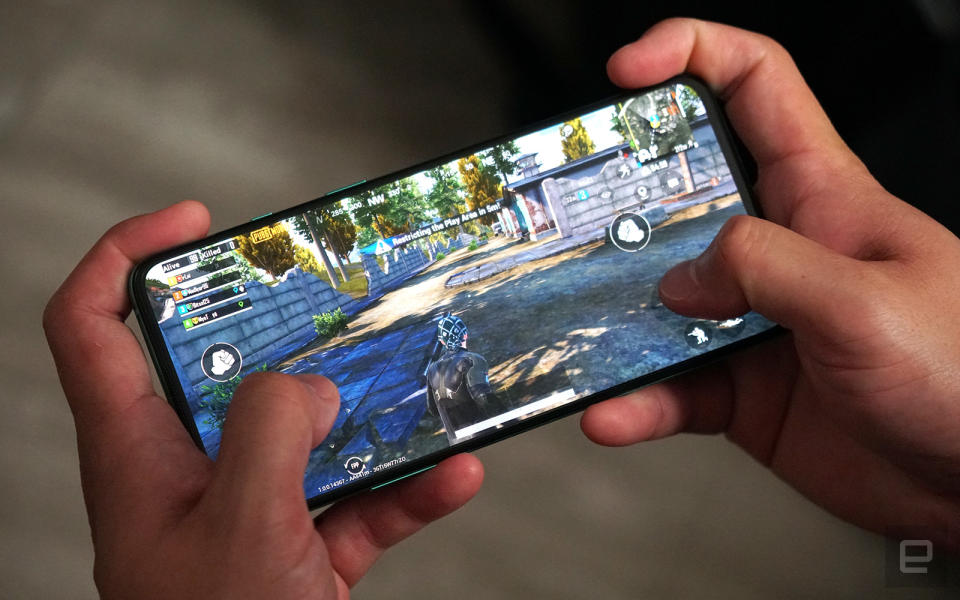
With the OnePlus 8T’s 4,500mAh battery, I generally got about 13 to 15 hours per charge, which sounds about right when compared to Chris Velazco’s 12-hour battery life on the 8 Pro, which had a sharper screen. If you want to squeeze more battery out of the 8T, you can lower the screen’s refresh rate to 60Hz, but I never had to, given the adequate battery life. And again, I cannot stress enough how convenient Warp Charge 65 is -- I could comfortably leave home with the phone after just a 15-minute emergency charge.
I also kept an eye on power consumption while playing PUBG Mobile: with HDR graphics and “extreme” frame rate enabled manually, a 40-minute session drained about 20 percent of battery juice. That’s a lot. I then disabled HDR and lowered the frame rate by one level to “ultra,” and my subsequent 40-minute playthrough used up about half as much battery, without heating up the phone so much.
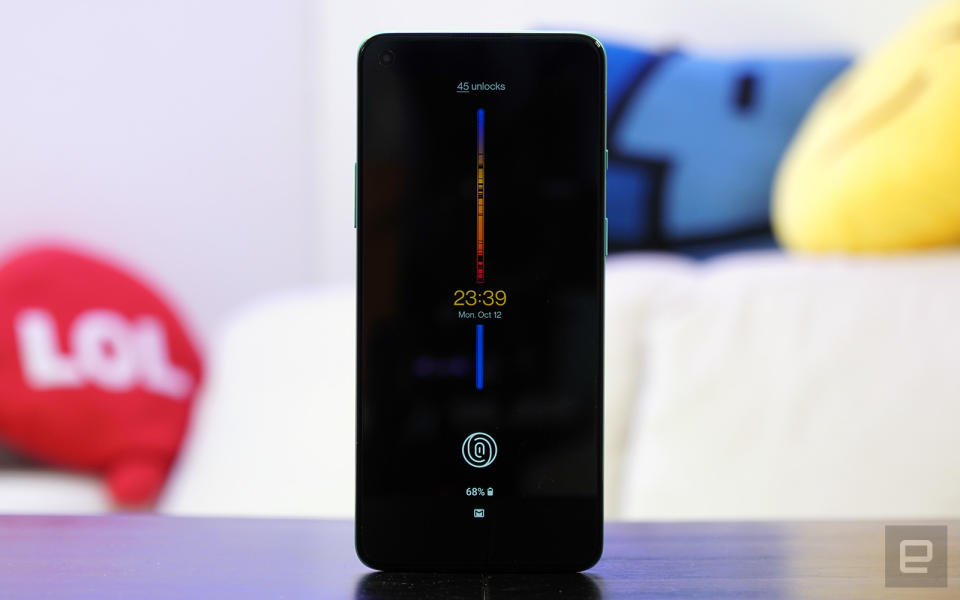
Software
OnePlus’ take on Android 11, OxygenOS 11, doesn’t look that much different than before; it’s just as simple and clean, but dotted with a few handy new features. My favorite one is the Insight AOD (always-on display), which is a collaboration between OnePlus and Parsons School of Design to visualize a user’s digital wellbeing. Once enabled, you’ll see a thin gradient column -- with a clock slowly moving downward throughout the day -- that occasionally switches position on the black screen. Each time you unlock the phone, you create a gap in the bar, the idea being to make you realize how reliant you are on your phone. You’d probably even feel guilty about ruining this otherwise beautiful piece of digital artwork, you horrible, horrible person.
If you want to do something about your mobile addiction, OxygenOS 11 offers a new Zen Mode 2.0. Like before, this can lock you out of your phone for a set period of time, but now, there’s a “group Zen Mode” which lets you invite friends to install the app (it works on non-OnePlus phones as well) and “zone out” together -- think dinner parties or meetings. But because of COVID-19, it’ll probably be a while until we get to try this with others in person.
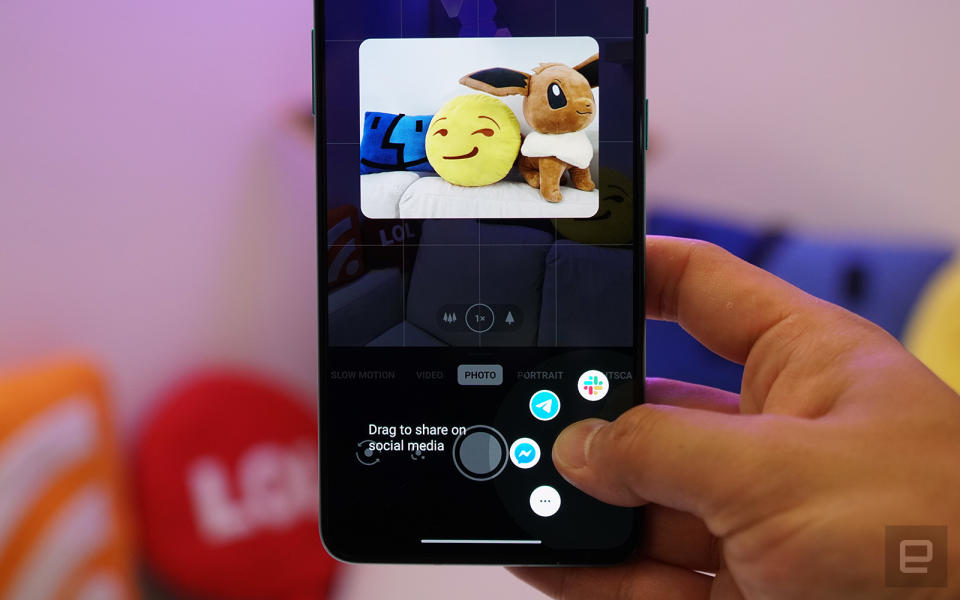
OnePlus continues to focus on optimizing one-handed control, which we’ve seen in built-in apps like Weather, Settings and Shelf (OnePlus’ own pull-down widget page) with their “golden ratio” layouts -- these make for easier thumb access. Now in OxygenOS 11, the camera app has gained a more intuitive thumb-friendly feature: long press the thumbnail at the bottom right brings up a quick share dial, then just drag your thumb to one of the three recently used social apps to share your latest shot. This had saved me a few taps for direct sharing, though I wish I could customize the shortcuts to quickly edit in, say, Photoshop Express.
Sadly, a handful of other new features won’t arrive until some time in November. The one that I’m most looking forward to is Voice Note, which will convert speech to text on the fly while recording in the Notes app, and it’ll support English plus Mandarin Chinese to begin with. There will also be a “Straighten Doc” tool in the camera and gallery apps, and this can automatically spot and optimize text documents in your shots. (I had already been using a similar tool on my Find X2 Pro, so I wouldn’t be surprised if this turns out to be a direct port from Oppo’s side.)

Cameras
The OnePlus 8T is equipped with the same 48-megapixel main camera as the 8, which is a little disappointing. Don’t get me wrong, this Sony IMX586 sensor did a good job on bright, sunny days, but compared to the more powerful IMX689 sensor on the 8 Pro and the Find X2 Pro, I noticed a drop in dynamic range and detail, especially at night. Even with HDR enabled automatically, the darker buildings in the background quickly disappeared in my nighttime street shots. My nighttime 4K videos also turned out to be a bit soft.
You’ll also find the same 16-megapixel hole-punch selfie camera found on both the 8 Pro and the 8, and again, it could be better. My outdoor selfies looked fine in terms of details, but the colors were a little washed out. It was really the indoor shots where the phone struggled, as slow capture time meant I would often end up with soft and shaky shots.
Luckily, the new 16-megapixel ultra-wide camera and 5-megapixel macro camera performed surprisingly well. Even though the former is labeled with an impressive 123-degree field of view, the lens correction (enabled by default) brings this down to 111.7 degrees. The results were mostly solid -- sometimes even sharper and more vibrant than the main camera at night. As for the new macro camera, it is a vast leap from the utterly disappointing 2-megapixel counterpart on the OnePlus 8 -- the shots no longer look like they were captured with an old webcam.
There’s actually a fourth camera, a 2-megapixel monochrome camera situated below the two LED flashlights. I assumed this was for directly capturing monochrome photos, but OnePlus clarified that the camera app’s monochrome mode still uses the main camera to capture, with the lesser monochrome camera assisting it by collecting and analyzing additional environmental data to enhance black and white shots. Compared to the OnePlus 8’s monochrome photos, the 8T’s more closely resemble classic black and white photos, with greater sharpness and contrast along with grainy texture.
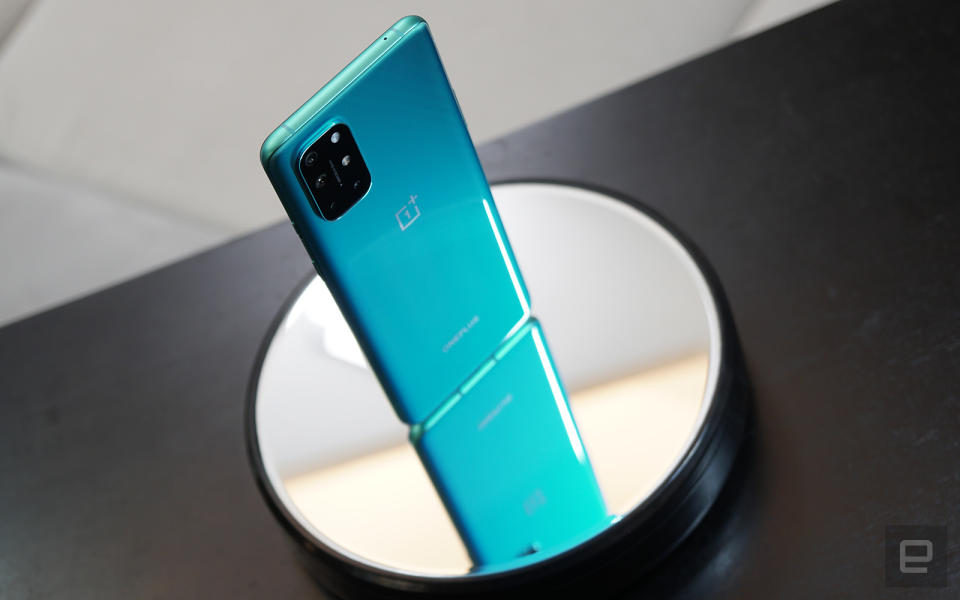
Wrap-up
Even though the OnePlus 8T is a mid-cycle model for the company, it impresses. It is very much a downsized OnePlus 8 Pro, inheriting the same screen refresh rate and almost-identical battery size, but puts it in a smaller, easier-to-hold package. There’s even 65W fast charging, which has been one of my favorite smartphone technological breakthroughs this year. All of these, combined with the slick OxygenOS 11, make for a great smartphone experience.
It’s not perfect though. The OnePlus 8T is let down by the general camera experience and hardware design. It felt like OnePlus was holding back on better cameras, especially when the 8 Pro or the 8 had similar camera issues. Maybe that’s the problem with a mid-cycle model: OnePlus probably wanted to save something special for the next major release. Or maybe it was a production cost issue, but then again, the OnePlus 8T is now fighting hand to hand with Samsung’s even cheaper Galaxy S20 FE, which might take better photos.
The OnePlus 8T is a great choice among the latest crop of flagship phones. It focuses on practicality, speed and, to an extent, value. For some, this will be all they need -- at least until the OnePlus 9 comes along.
Key specs
OnePlus 8T | |
|---|---|
Processor | Octa-core Snapdragon 865 |
RAM / storage | 12GB/256GB |
MicroSD card support | N/A |
Display | 6.55-inch 120Hz Fluid AMOLED |
Display resolution | 2,400 x 1,080 |
Rear cameras | 16MP f/2.2 ultra-wide-angle camera, 48MP f/1.7 wide-angle camera with OIS, 5MP macro camera, 2MP monochrome camera |
Front-facing camera | 16MP f/2.4 punch-hole camera |
OS | OxygenOS 11, based on Android 11 |
Battery | 4,500mAh |
Charging | USB-C, supports Warp Charge 65 and USB-PD (up to 27W) |
Dimensions | 160.7 x 74.1 x 8.4mm |
Weight | 188g |
Fingerprint sensor | Yes, in-display |
Waterproofing | N/A |
NFC | Yes |
Headphone jack | No |
5G | Yes, sub-6 |


